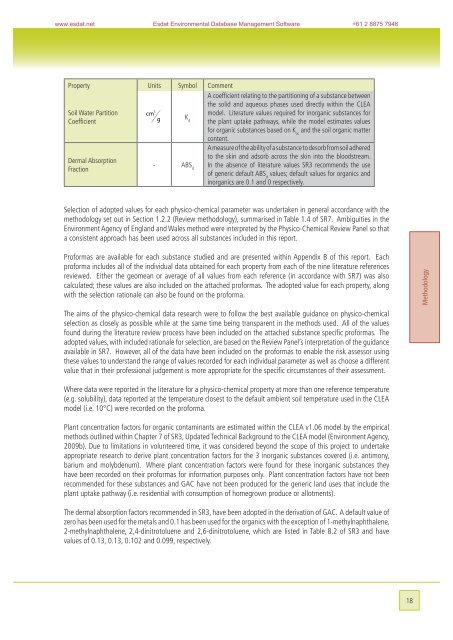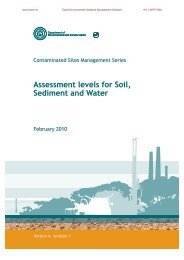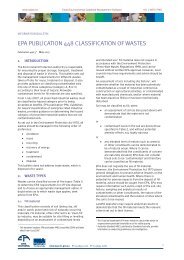Soil Generic Assessment Criteria for Human Health Risk ... - ESdat
Soil Generic Assessment Criteria for Human Health Risk ... - ESdat
Soil Generic Assessment Criteria for Human Health Risk ... - ESdat
You also want an ePaper? Increase the reach of your titles
YUMPU automatically turns print PDFs into web optimized ePapers that Google loves.
www.esdat.net Esdat Environmental Database Management Software +61 2 8875 7948<br />
Property Units Symbol Comment<br />
<strong>Soil</strong> Water Partition<br />
Coefficient<br />
Dermal Absorption<br />
Fraction<br />
€<br />
A coefficient relating to the partitioning of a substance between<br />
the solid and aqueous phases used directly within the CLEA<br />
cm 3 model. Literature values required <strong>for</strong> inorganic substances <strong>for</strong><br />
g K d<br />
the plant uptake pathways, while the model estimates values<br />
<strong>for</strong> organic substances based on K oc<br />
and the soil organic matter<br />
content.<br />
A measure of the ability of a substance to desorb from soil adhered<br />
to the skin and adsorb across the skin into the bloodstream.<br />
- ABS d<br />
In the absence of literature values SR3 recommends the use<br />
of generic default ABS d<br />
values; default values <strong>for</strong> organics and<br />
inorganics are 0.1 and 0 respectively.<br />
Selection of adopted values <strong>for</strong> each physico-chemical parameter was undertaken in general accordance with the<br />
methodology set out in Section 1.2.2 (Review methodology), summarised in Table 1.4 of SR7. Ambiguities in the<br />
Environment Agency of England and Wales method were interpreted by the Physico-Chemical Review Panel so that<br />
a consistent approach has been used across all substances included in this report.<br />
Pro<strong>for</strong>mas are available <strong>for</strong> each substance studied and are presented within Appendix B of this report. Each<br />
pro<strong>for</strong>ma includes all of the individual data obtained <strong>for</strong> each property from each of the nine literature references<br />
reviewed. Either the geomean or average of all values from each reference (in accordance with SR7) was also<br />
calculated; these values are also included on the attached pro<strong>for</strong>mas. The adopted value <strong>for</strong> each property, along<br />
with the selection rationale can also be found on the pro<strong>for</strong>ma.<br />
Methodology<br />
The aims of the physico-chemical data research were to follow the best available guidance on physico-chemical<br />
selection as closely as possible while at the same time being transparent in the methods used. All of the values<br />
found during the literature review process have been included on the attached substance specific pro<strong>for</strong>mas. The<br />
adopted values, with included rationale <strong>for</strong> selection, are based on the Review Panel’s interpretation of the guidance<br />
available in SR7. However, all of the data have been included on the pro<strong>for</strong>mas to enable the risk assessor using<br />
these values to understand the range of values recorded <strong>for</strong> each individual parameter as well as choose a different<br />
value that in their professional judgement is more appropriate <strong>for</strong> the specific circumstances of their assessment.<br />
Where data were reported in the literature <strong>for</strong> a physico-chemical property at more than one reference temperature<br />
(e.g. solubility), data reported at the temperature closest to the default ambient soil temperature used in the CLEA<br />
model (i.e. 10°C) were recorded on the pro<strong>for</strong>ma.<br />
Plant concentration factors <strong>for</strong> organic contaminants are estimated within the CLEA v1.06 model by the empirical<br />
methods outlined within Chapter 7 of SR3, Updated Technical Background to the CLEA model (Environment Agency,<br />
2009b). Due to limitations in volunteered time, it was considered beyond the scope of this project to undertake<br />
appropriate research to derive plant concentration factors <strong>for</strong> the 3 inorganic substances covered (i.e. antimony,<br />
barium and molybdenum). Where plant concentration factors were found <strong>for</strong> these inorganic substances they<br />
have been recorded on their pro<strong>for</strong>mas <strong>for</strong> in<strong>for</strong>mation purposes only. Plant concentration factors have not been<br />
recommended <strong>for</strong> these substances and GAC have not been produced <strong>for</strong> the generic land uses that include the<br />
plant uptake pathway (i.e. residential with consumption of homegrown produce or allotments).<br />
The dermal absorption factors recommended in SR3, have been adopted in the derivation of GAC. A default value of<br />
zero has been used <strong>for</strong> the metals and 0.1 has been used <strong>for</strong> the organics with the exception of 1-methylnaphthalene,<br />
2-methylnaphthalene, 2,4-dinitrotoluene and 2,6-dinitrotoluene, which are listed in Table 8.2 of SR3 and have<br />
values of 0.13, 0.13, 0.102 and 0.099, respectively.<br />
18








